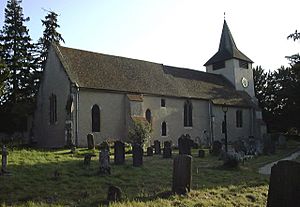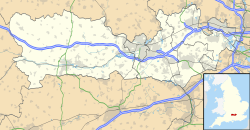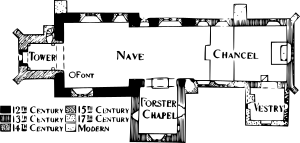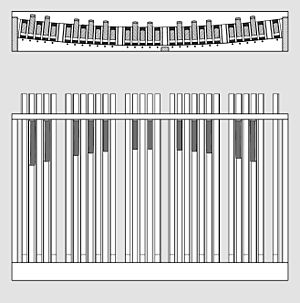Church of St Mary the Virgin, Aldermaston facts for kids
Quick facts for kids Church of St Mary the Virgin |
|
|---|---|

A view of the church from the graveyard
|
|
| 51°22′51″N 1°08′39″W / 51.3807°N 1.1442°W | |
| Location | Church Road, Aldermaston, Berkshire |
| Country | England |
| Denomination | Anglican |
| History | |
| Founded | Mid 12th century |
| Dedication | St Mary the Virgin |
| Architecture | |
| Functional status | Active |
| Heritage designation | Grade I |
| Style | Norman |
| Administration | |
| Parish | Aldermaston |
| Deanery | Bradfield |
| Archdeaconry | Berkshire |
| Diocese | Oxford |
The Church of St Mary the Virgin is a Church of England parish church located in Aldermaston, Berkshire. This historic church is dedicated to St Mary. It was first built in the mid-12th century and shows examples of both Norman architecture (an old style from the time of the Normans) and Jacobean architecture (a style from the time of King James I). Over the centuries, the church has been made larger with new parts added, especially in the 13th, 14th, 15th, and 17th centuries.
History of the Church
The Church of England parish church was originally built in the middle of the 12th century. This early Norman building has been changed and added to many times over the last 900 years. The main part of the church, called the nave, is from the 12th century. Other parts were added later, like the Forster Chapel and the chancel (the area around the altar) in the 13th century. The tall steeple was added in the 14th century, and a small room called the vestry was built in the 17th century.
The church has a special pulpit (where the priest gives sermons) from the 17th century. It has an unusual seven-sided shape. More changes were made in the 14th and 15th centuries, mostly to the walls and the windows, which have a wavy, pointed shape called an ogee. A "scratch dial," which is like an old sundial, was added to a wall support on the outside in the 14th century.
In 1896, a big renovation of the church took place. Charles Keyser paid for this work, and Edward Doran Webb guided the project. During these repairs, workers found an old water drainage system in a window sill, which was then turned into a piscina (a basin used for washing sacred vessels). They also found that the walls of the nave were covered with plaster over a wooden frame. This was removed, and the walls were decorated with tempera artwork (a type of paint). The beautiful stained glass windows in the chancel were made by a famous artist named C.E. Kempe.
More repairs were done to the roof and tower in the 1950s. The church's font, used for baptisms, is from the mid-19th century. The lectern, where readings are given, is a memorial to those who served in the Second World War.
On September 11, 2010, the church opened its doors to the public as part of the Heritage Open Days event, allowing visitors to explore its history. The current rector (the main priest) is Jane Manley.
Forster Chapel
The south transept (a part of the church that sticks out, making it look like a cross) was added in the 13th century. This area is now known as the Forster Chapel. Inside, you can see a special alabaster monument from 1530. It shows statues of Sir George Forster and his wife Elizabeth. Part of the monument was damaged when the church roof collapsed, but George's face remained untouched. This chapel might have originally been a chantry, a place where prayers were said for the dead, dedicated to St Nicholas.
The two round windows in the north part of the chapel show pictures of the Annunciation (when an angel told Mary she would have a baby) and the Coronation of the Virgin (Mary being crowned in heaven). These windows are from the 13th century and are the oldest stained glass in all of Berkshire.
Church Bells
The church tower has a set of eight bells. The oldest bells are the fourth and sixth, which were made in 1681 by Henry Knight of Reading. The seventh bell was made in 1786 by W & T Mears. The third and fifth bells were cast by Mears in 1860. The second bell was made by Warner in 1895, and the smallest (treble) and largest (tenor) bells were added five years later.
Between 1900 and 2005, the church bells were rung for 210 "peals." A peal is a long ringing of all the bells in a special pattern. In 1977, the bells rang a "quarter-peal" (1260 changes) to celebrate the Silver Jubilee of Elizabeth II (50 years since Queen Elizabeth II became Queen). On July 9, 1979, a full peal was rung to celebrate the Queen and the Duke of Edinburgh's visit to AWRE (Atomic Weapons Establishment). Another peal was rung on November 15, 1980, to welcome the new vicar, Richard Millar. That peal lasted 2 hours and 47 minutes!
Church Organ
The organ at St Mary's church is in the south chancel. It was built in 1880 by Martin & Coate of Oxford. The organ has 9 stops, which are like different sets of pipes that make various sounds. The pipes are made from a shiny metal alloy of lead and tin.
| Part of Organ | Sound Name | Pipe Length |
|---|---|---|
| Pedal | Bourdon | 16' |
| Great | Open Diapason | 8' |
| Stopped Diapason | 8' | |
| Dulciana | 8' | |
| Principal | 4' | |
| Swell | Horn Diapason | 8' |
| Gamba | 8' | |
| Lieblich Gedact | 8' | |
| Gemshorn | 4' | |
| Tremulant |
The organ also has four "couplers," which connect different parts of the organ so that one keyboard can play pipes from another section. The wind system, which blows air through the pipes, uses an electric blower. The pedal keyboard, played with the feet, is shaped in a special "concave-parallel" design.
In 1938, a "tremulant" was added to the swell section, which makes the sound waver slightly. The swell to great coupler was also changed, and some details were added to the console (the part with the keyboards and stops). In 1997, the organ was cleaned and repaired by Foster Waite of Newbury, but no major changes were made to its sound.
Notable Burials
Several interesting people are buried in the Aldermaston churchyard.
Maria Hale, born in 1791, lived in a small house near the court's parkland. There were many old stories about her in the village. She passed away in 1879 and was buried near a yew tree, south-west of the church entrance.
Charles Keyser, who funded the church's renovation in 1896, is also buried in the Aldermaston churchyard. Other notable people buried here include Daniel Burr and John Stair.




